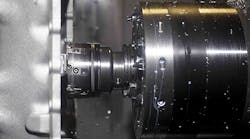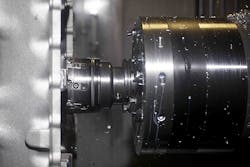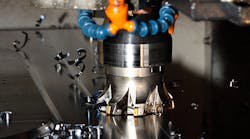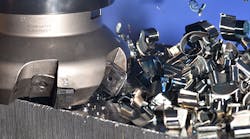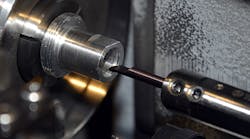In one of its first U.S. high-volume applications outside the automotive industry, a breakthrough PCD cartridge-type facemill has dramatically improved rough and finish milling for aluminum castings. Continental Motors in Mobile, AL, a manufacturer of piston-type aircraft engines, reports:
• Much improved flatness and finish;
• Quadrupled material removal rate (MRR) for roughing, versus ICI mills; and
• Doubled MRR for finish milling versus another PCD cartridge cutter
Since mid-2011, AS9100-certified Continental has standardized on Ingersoll TEDI mill facemills to rough and finish cast aluminum engine crankcases. The operations, which involve heavy interrupted cuts, run continuously on a Toyoda FH630SX horizontal CNC machine to produce 1,750 crankcases/year in a 250-man shop.
The crankcases measure 12-15 inches high and vary in length from 22 and 30 inches. They actually have two faces to machine: an inner face that provides the seal and an outer “show” face for appearance. Typical of aluminum castings, the microstructure is rife with abrasive mineral alumina (aluminum oxide, Al2O3), which can quickly blunt cutting edges.
TEDI mill facemills are the only cutting tools offered as standards from Ingersoll Cutting Tools’ affiliate in the IMC Group, Italian Technical Diamond Company (IT.TE.DI). Until now, the company has specialized in custom high-precision PCD and CBN boring tools. After convincing successes with global automakers as “specials”, Ingersoll brought the TEDI mill line to the U.S. market in 2011, first as a special and now as a standard.
Unlike any other PCD cartridge mills, the Ingersoll-TEDI mill cutter features absolutely rigid cartridge seating, positive-rake presentation and coolant delivery directly to the cutting edge. Insert corner radii are replaced by small, 45-degree chamfer to reduce axial cutting forces. They are also balanced to qualify for 20,000 RPM/16,000SFM ratings right out of the box. Craig Bastian, Ingersoll’s product manager for the IT.TE.DI. line, reported that the tools withstood 54,000 RPM in independent tests conducted on the fastest spindle in the world.
The result is chatter-free milling at high spindle speeds and feed rates that may defy belief.
Performance Tests Reassure the Skeptics
In fact, Continental’s manufacturing engineer Mike Brown was skeptical at first, until a shop-floor demo showed that a 6-in., TEDI mill cutter could reliably run at 10,000 RPM and 400 IPM feed rate.
The retooling began during Mike Brown’s regular plant walk-through with Ingersoll’s Bruce Burroughs, when the focus turned to saving time on the standard finish milling operation. On larger crankcases, the heat of machining often built up to the point that the parts had to be unclamped and reclamped to relieve machining stresses. The tool in use was a mainstream 6-in., PCD zero-rake cartridge cutter.
Burroughs suggested trying the new TEDI mill cutter because of its much more rigid cartridge clamping and seating system. “In the TEDI mill cutter, the cartridge is clamped to stop movement on one direction and wedged to stop movement in the other direction,” Burroughs explained. “This eliminates the root cause of chatter.”
Trials were conducted on Continental’s Toyoda, to both validate the new tool and establish machining parameters for operational use. Here are the highlights:Actually, Continental cut the feeds and speeds back a little when going operational. “This was simply for peace of mind about our spindle, not for any limitation with the tool,” Brown explained. One of his machinists once worked for a machine rebuilder and had seen a lot of spindle damage, and convinced Brown to be conservative.
Otherwise, they stuck to the parameters developed in the trial. The operation ran without incident from Day One.
About the same time, the tragic tsunami in Japan got Mike Brown thinking about surety of supply for the Japanese carbide inserts used for crankcase roughing. He asked Bruce Burroughs about an alternative, and Burroughs recommended a 4-in. TEDI mill, the same diameter as the ICI mill then in use. The roughing trial, which ran on the same day as the finish-milling test, produced these results and parameters:Continental immediately adopted the 4-in. TEDI mill for roughing, and got a doubling of throughput on that operation as well.
“Three keys to success of the Ingersoll-TEDI mill at Continental Motors are the more rigid cartridge clamping scheme, coolant presented directly to the cutting edge, and free-cutting presentation geometry,” according to Ingersoll’s Craig Bastian. “No other PCD cartridge mill comes even close. The others are either zero rake or negative rake, and none that I know of offer coolant presented directly to the cutting edge. None come out of the box with a 20,000 RPM/16,000 SFM rating like the TEDI mill.”
The TEDI mill also features smooth, precise, simple axial adjustment of cartridges to 2 microns, according to Bruce Burroughs.
Brown adds that the smaller chamfer on the insert substantially reduces axial cutting forces and resultant machining stresses. “All told, the operation has kept running better and better since the retooling,” Brown said. “The cutting area stays cooler as well, which reduces part distortion from machining stresses that can lead to rejects or slow the operation down.”
In fact, such overheating and stresses can lead to reworks to correct flatness, especially on the larger parts. “We used to have to unclamp and reclamp the larger crankcases to avert this problem,” Brown said. “Not anymore.”
Based on the experience to date, Brown plans to standardize on the TEDI mill for all operations that run on mills with the requisite spindle speed and plumbing to take full advantage. “TEDI mills are not cheap, so there’s no reason to put them on machines that can’t take full advantage of all their features,” he concluded.
Burroughs added that automotive successes with TEDI mill cartridge mills are in both aluminum and cast iron. CBN cartridges are used for cast iron, PCD for aluminum.
